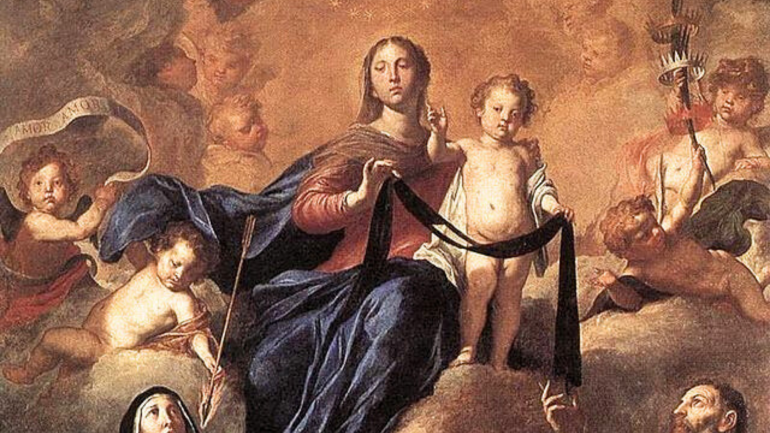Scapular: To Fight Evil Under the Gaze of Our Lady

While the scapular is not a magical charm or guarantee of salvation, it symbolizes a conscious choice to follow Jesus through Mary.
Among the many devotions in the Catholic Church that draw the faithful closer to Jesus through Mary, the Brown Scapular of Our Lady of Mount Carmel holds a special place. Rooted in the deep Marian heritage of the Carmelite Order, this devotion invites believers to imitate Mary’s virtues, seek her maternal protection, and walk the path of discipleship with greater fidelity. More than just a symbol, the scapular is a daily reminder of one’s baptismal promises, a spiritual habit woven into ordinary life, encouraging faith, humility, and obedience.
Historical Roots and Significance
The feast of Our Lady of Mount Carmel, celebrated annually on July 16, holds profound significance for the Carmelite Order, emphasizing their deep spiritual connection to Mother Mary and their heritage. The origins of this feast date back to around 1386, commemorating the protection and blessings bestowed upon the Carmelites during challenging times, most notably during the Ecumenical Council of 1274, when their existence was questioned.
The Meaning and Symbolism of the Scapular
Central to Carmelite devotion is the Brown Scapular, symbolizing membership in the Carmelite family, consecration to Mary, and a commitment to embody her virtues. Traditionally, monks wear a lengthy scapular over their shoulders, chest, and back during work hours, reminding them of the "sweet yoke" of Christ and recalling Gospel teachings. Laypersons aspiring to join the Order wear a symbolic scapular instead of the full habit or long scapular.
The Scapular of the Carmelite Order typically bears an image of Our Lady of Mount Carmel on one side and the Order's coat of arms on the other, featuring a mount with three stars for the Carmelites and a mount with a cross and three stars for the Discalced Carmelites. While religious men and women wear the long scapular, members of the Secular Order of Carmel wear a smaller one known as the "little habit." For all Carmelites, the scapular holds deep spiritual significance as a sacred Marian symbol. It is a sacramental, not a sacrament, instituted by the Church as a sign of devotion and a plea for grace.
Spiritual Meaning of the Brown Scapular
The Brown Scapular serves as:
- A constant reminder of God's love through the Most Holy Trinity, Jesus the Word Incarnate, the Church, and our Mother Mary.
- A gentle push to turn to Mary, to experience and reciprocate God's boundless love, emulating her theological and moral virtues, and promoting devotion to her.
- A promise of privileges bestowed by the Virgin's presence, guiding believers in daily life to avoid harm, engage in spiritual and corporal acts of mercy, and offer peace and intercession.
Popes and Church documents have consistently endorsed the use of the Carmelite scapular, paralleling their endorsement of the Rosary. Pius XII explained that wearing the scapular is akin to adopting the spirit of a 13th-century knight who found courage and assurance in battle under the gaze of his lady. Pope St. John Paul II, in his message to the Carmelite Family in 2001 marking the 750th anniversary of the scapular's bestowal, concluded with these words: “I have also worn the scapular of Carmel close to my heart for many years!”
Witness of the Saints and Martyrs
The Scapular of Carmel is revered as the "Armour of God," symbolizing spiritual protection and Mary's maternal care for those who wear it devoutly. Throughout history, saints and blessed members of the Carmelite family, such as St. Teresa of Avila, St. Thérèse of Lisieux, and St. Teresa Benedicta of the Cross, cherished the Brown Scapular as a tangible sign of their devotion to Mary. Their writings and experiences reflect deep spiritual connections to Our Lady of Mount Carmel, embodying virtues of faith, humility, and prayerfulness.
Blessed Isidore Bakanja (1885–1909), a humble labourer from Congo, exemplified this devotion. Baptized by the Trappist Fathers of Belgium, he received a Scapular of Mount Carmel and a Rosary. Isidore courageously taught his faith, even when pressured by an atheist Belgian official named Van Cauter to renounce his beliefs and remove the scapular. Refusing to compromise, Isidore endured martyrdom, forgiving his persecutor and praying for him at the moment of his death. His steadfast devotion earned him the title of Blessed by Pope John Paul II in 1994, a testament to his commitment to the Rosary and the Scapular of the Virgin of Carmel.
A Symbol of Commitment, Not Magic
While the scapular is not a magical charm or guarantee of salvation, it symbolizes a conscious choice to follow Jesus through Mary, fostering a deeper relationship with God in daily life. As a sacramental, its power lies in the wearer’s faith, devotion, and willingness to live a Christ-centered life in imitation of Mary.
A Call to Deeper Devotion
The devotion to Our Lady of Mount Carmel and the wearing of the Brown Scapular is a spiritual invitation—an invitation to imitate Mary in her humility, faith, and openness to God. By wearing the scapular with devotion and living according to its spirit, one is drawn into a deeper communion with Christ under the gentle guidance and intercession of His Mother.
(Br. John Malvino Alfonso, OCD, is a member of the Karnataka-Goa Province of the Order of Discalced Carmelites, based at Avila Jyothi, Mapusa, Goa, India.)








